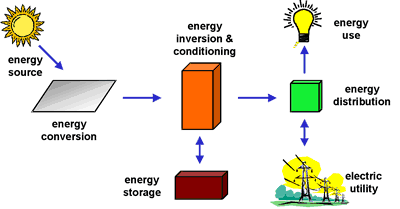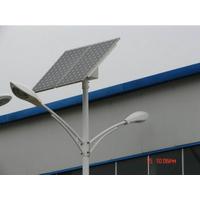Solar electric systems, also known as photovoltaic (PV) systems,
convert sunlight into electricity.

Solar cells—the basic building blocks of a PV system—consist of
semiconductor materials. When sunlight is absorbed by these
materials, the solar energy knocks electrons loose from their
atoms. This phenomenon is called the "photoelectric effect." These
free electrons then travel into a circuit built into the solar cell
to form electrical current. To see a simulation of the
photoelectric effect, please view our animation. Only sunlight of
certain wavelengths will work efficiently to create electricity. PV
systems can still produce electricity on cloudy days, but not as
much as on a sunny day.
The basic PV or solar cell typically produces only a small amount
of power. To produce more power, solar cells (about 40) can be
interconnected to form panels or modules. PV modules range in
output from 10 to 300 watts. If more power is needed, several
modules can be installed on a building or at ground-level in a rack
to form a PV array.
PV arrays can be mounted at a fixed angle facing south, or they can
be mounted on a tracking device that follows the sun, allowing them
to capture the most sunlight over the course of a day.
Because of their modularity, PV systems can be designed to meet any
electrical requirement, no matter how large or how small. You also
can connect them to an electric distribution system
(grid-connected), or they can stand alone (off-grid).
Simply put, PV systems are like any other electrical power
generating systems, just the equipment used is different than that
used for conventional electromechanical generating systems.
However, the principles of operation and interfacing with other
electrical systems remain the same, and are guided by a
well-established body of electrical codes and standards.
Although a PV array produces power when exposed to sunlight, a
number of other components are required to properly conduct,
control, convert, distribute, and store the energy produced by the
array.
Depending on the functional and operational requirements of the
system, the specific components required may include major
components such as a DC-AC power inverter, battery bank, system and
battery controller, auxiliary energy sources and sometimes the
specified electrical load (appliances). In addition, an assortment
of balance of system (BOS) hardware, including wiring, overcurrent,
surge protection and disconnect devices, and other power processing
equipment. Figure 3 show a basic diagram of a photovoltaic system
and the relationship of individual components.

Figure 1. Major photovoltaic system components.
Batteries are often used in PV systems for the purpose of storing
energy produced by the PV array during the day, and to supply it to
electrical loads as needed (during the night and periods of cloudy
weather). Other reasons batteries are used in PV systems are to
operate the PV array near its maximum power point, to power
electrical loads at stable voltages, and to supply surge currents
to electrical loads and inverters. In most cases, a battery charge
controller is used in these systems to protect the battery from
overcharge and overdischarge.








